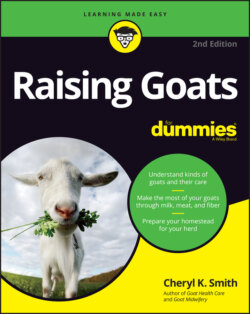Читать книгу Raising Goats For Dummies - Cheryl K. Smith - Страница 75
Boer goats
ОглавлениеBoer goats are large, heavy animals that resemble Nubians because of their Roman noses and floppy ears. They’re white and reddish-brown (although some are all red) or black, as well as spotted and dappled, and many are horned. Their horns are short and curve back close to the head. Bucks can weigh from 260 to 380 pounds and does from 210 to 265 pounds. Figure 3-6 shows a Boer buck.
FIGURE 3-6: A South African Boer buck.
Boers are originally from South Africa, where they were bred for hardiness. They came into the United States from New Zealand and Australia through Canada and continue to grow in popularity. Based on the increased number of men I saw at our local goat conference, the Boers are catching on. (Past conferences have drawn mainly dairy goat owners, who traditionally are women.)
If you want a purebred, high-quality Boer, expect to pay a lot. Boers are one of the most expensive breeds in the United States. That doesn’t mean that all of them are expensive, though; you can still get some good foundation stock (the stock you start your breeding program with) if you look around.
At least two organizations register Boer goats, including the American Boer Goat Association (ABGA) and the United States Boer Goat Association (USBGA).
Boers are quite adaptable and hardy, and most are affectionate and mild-mannered. Their adaptability leads them to browse more than dairy goats because they can easily handle both heat and cold. Boers do have some fairly common genetic defects you need to watch for, including extra teats and abnormal testicles.
Some breeders of large dairy goats, such as Nubians, cross their does to a Boer bucks. This has the added advantage of selling the kids for milk while freshening the does for another year of milking.
